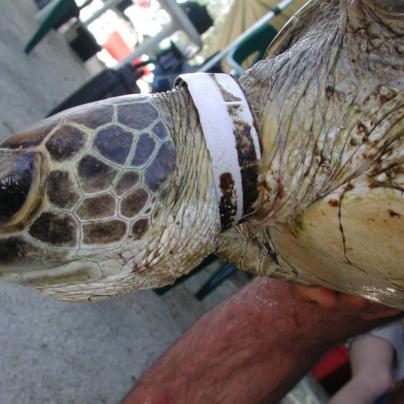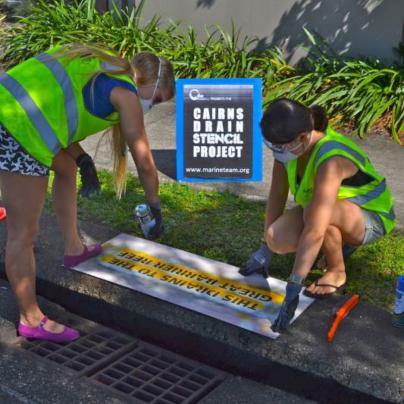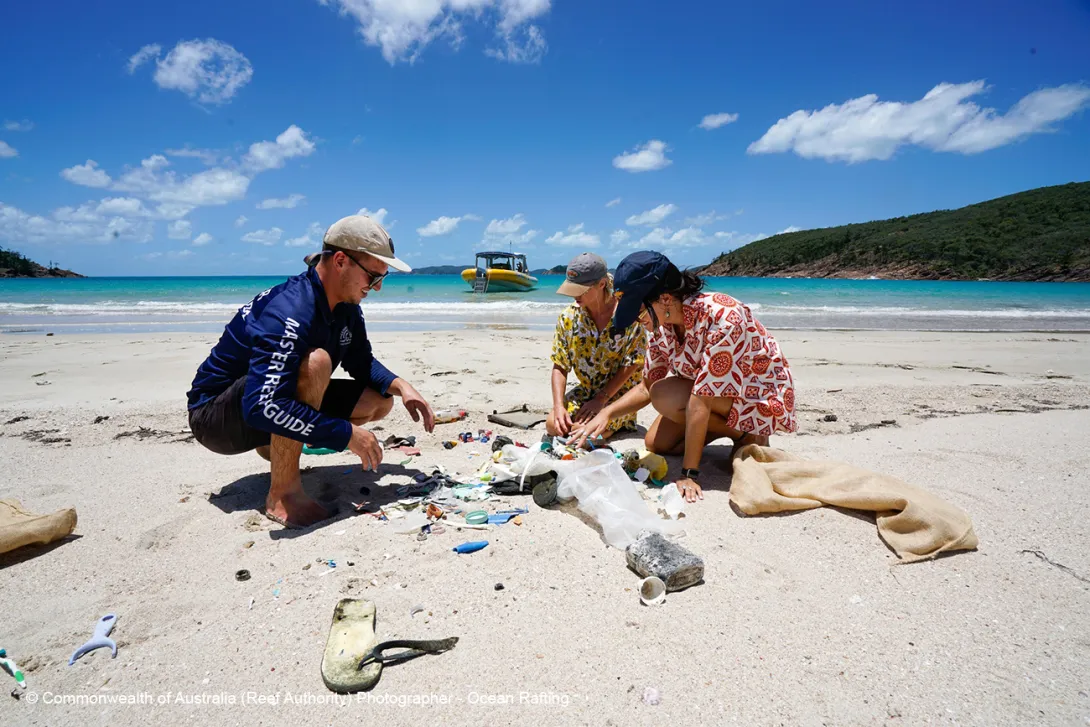Marine debris is a major threat to the health of the Great Barrier Reef and kills marine life such as turtles, dugongs, dolphins and seabirds. Collective action by community, industry and government to choose sustainable options, minimise waste and undertake stewardship activities is required to reduce the impacts of marine debris on the Reef.
Marine debris is rubbish that finds its way into the marine environment. Debris can make its way to the Great Barrier Reef through stormwater drains, during severe weather events, from international waters, and accidental or deliberate littering from shipping or boating activities. It can be made up of wood, metal, shopping containers, foam, rubber, glass and plastic.
- Plastic litter is an increasing threat to the Reef. More than 80 per cent of marine debris found in the Reef is plastic, which can break up into smaller pieces and travel vast distances, increasing the risk of impacts. Plastic marine debris can include:
- macroplastics: plastic items greater than five millimetres in size, such as plastic bottles and straws
- microplastics: plastic items less than five millimetres in size, such as microbeads from personal care products, microfibres from synthetic clothes materials
- secondary microplastics which have been broken up from larger pieces of macroplastics
- abandoned, lost or discarded fishing gear, such as crab pots and fishing nets.



Impacts on the Marine Park and our oceans
Marine debris negatively impacts all of the Reef’s values – its beauty, rich biodiversity, extensive natural habitats, historic heritage, and Aboriginal and Torres Strait Islander cultural values.
Marine debris kills marine life. It can smother coral, entangle wildlife or be ingested by animals. All species of sea turtle, more than half of all known species of marine mammal such as dolphins and whales, and sea-birds are negatively affected by marine debris. Plastic debris also has potential toxic effects on animals, caused by chemicals is plastic that leach out after being eaten.
Community and tourism benefits of the Reef may also be impacted, such as enjoyment, visual features, appreciation, tourism satisfaction and aesthetics of the Reef, as well as Aboriginal and Torres Strait Islander heritage values like totem species, stories, sites of significance and more. Marine debris has an extensive negative impact on the beauty of the Reef. It is very expensive and time consuming to pick up and remove. For example, it is not only difficult to clean this remote beach in the far north of the Great Barrier Reef, but to also transfer all debris to a station or landfill site.
Marine debris can also pose a navigation hazard. For example, approximately 3,500 shipping containers are lost at sea each year, posing a dangerous threat to yachts, boats and ships and neighboring reef should a vessel hit one.
Marine debris may also transport foreign species, such as invasive ants, that float into the Marine Park and potentially onto Great Barrier Reef islands. Developing contingency plans to identify pathways of introduction, and surveillance programs to detect and control or eradicate invasive ants on islands is part of the work of staff in the joint Field Management Program.

Management actions
The Authority supports immediate action at a local, national and international level to reduce all sources of marine debris, with the goal of stopping marine debris at the source or before release into the environment.
Marine debris position statement
On 1 March 2019, the Authority released our position statement on marine debris. The Authority’s position in response to the issues is:
Marine debris is a major threat to the health of the Great Barrier Reef and kills marine life such as turtles, dugongs, dolphins and seabirds. Collective action by community, industry and government to choose sustainable options, minimise waste and undertake stewardship activities is required to reduce the impacts of marine debris on the Reef.
- The statement explains what marine debris is, why it’s a major and increasing threat to the Reef and highlights the work of the Authority, governments and organisations to minimise its impacts. A variety of actions and outcomes are also presented which can be implemented globally to reduce the impacts of debris in the marine environment. We encourage others to adopt our position and take action to reduce all forms of marine debris entering the Marine Park and oceans around the world. The statement can be viewed here.
- Repurposing and reimagining includes changing the composition or function of products to minimise waste or non-renewable material, or re-designing products to reduce or remove plastic content. Two examples are the voluntary phase-out of personal care products containing microbeads, and the actions of the Australian Packaging Covenant Organisation to implement targets to reduce waste from packaging and improve recycling by 2025.
- Reducing and reusing plastic results in less plastic ending up in the Reef. Changes are required by industry and consumers to replace single-use plastic items like straws, coffee cups, pods and plastic beverage containers with reusable products that have lower overall environmental impacts. For example, Citizens of the Reef and partners have pledged to cease use of single-use plastics such as straws and the ban on single-use plastic bags by the Queensland Government.
- Recycling captures items that cannot be reused. There are many effective government policies in place that address recycling, including kerbside collection, the container refund scheme adopted by the Queensland Government.
- Recovering and removing marine debris through beach clean-ups and gross pollutant traps complement longer-term, strategic source reduction activities and anti-littering campaigns.
Reef Guardian program
The Authority’s Reef Guardian program collaboratively facilitates the adoption of ‘reef friendly’ behaviours and practices within the community led by schools, local government and industry. Supporting capacity-building activities help to reduce marine debris at source and promoting stewardship empowers stakeholders to be part of the solution.
With support through the Australian Government’s Reef Trust, we have already seen on-ground community clean-ups, targeted education and awareness-raising. For example, Traditional Owner groups, Local Marine Advisory Committees, organisations such as Tangaroa Blue and Eco Barge Clean Seas Inc, and many volunteers work hard to clean up the marine environment and the information they collect is used to help identify the source of marine debris.
Collaborating with international partners to guide actions to prevent and mitigate the impacts of marine debris is also a priority, such as the International Coral Reef Initiative and Commonwealth Clean Oceans Alliance.
